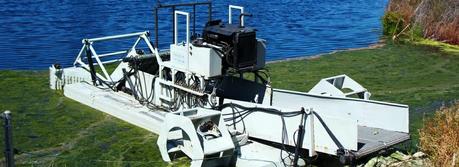 Harvesting algae (Credit: Eugene Zelenko, http://commons.wikimedia.org/wiki/User:EugeneZelenko)
Harvesting algae (Credit: Eugene Zelenko, http://commons.wikimedia.org/wiki/User:EugeneZelenko)Approximately 7,000 tons of microalgae are grown and used annually for a wide variety of applications, from biofuel production to livestock feeds and pharmaceuticals. However, the algae harvesting process is not very effective and uses up a lot of energy. Now, scientists at the National Physical Laboratory (NPL), London, propose to use an ultrasonic device to make algae harvesting easier.
The concentration of algae produced is very low, around 0.5% when grown in photobioreactors or open ponds. This means that almost all of the material that ends up in centrifuges to separate out the algae is water.
The Algaemax project is funded by the European Commission under the Seventh Framework Program, and is part of the Research for SME’s (R4SME) scheme. It aims to reduce the amount of energy needed to harvest algae. NPL is working alongside partners from Spain, the Netherlands, Turkey and the UK to develop an ultrasound-based flow processor, which will harness low power sound to increase the concentration of algae prior to harvesting and reduce the processing costs.
The Algaemax Flowcell will create acoustic standing waves in the liquid, which will generate local forces on particles, causing the algae to clump together. The designed cell will produce an algae-enhanced fluid at a concentration level or around 5%, which will then be separated out using commercial technologies.
The technical challenges include maintaining the resonant standing waves in the constantly changing fluid and ensuring that the algae is not destroyed by high acoustic pressures through the process of cavitation. This is where bubbles are formed and implode within a liquid creating high temperatures and pressures.
NPL will test design concepts, carry out theoretical modeling and liaise with suppliers to build and operate the Algaemax Flowcell in a laboratory environment.

